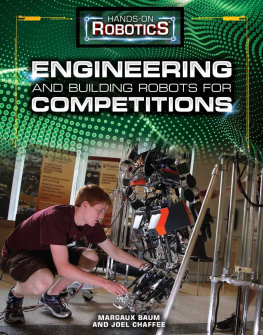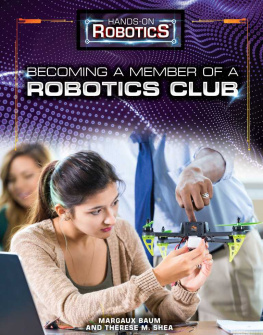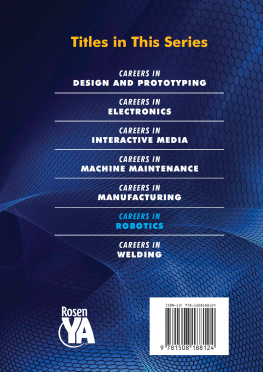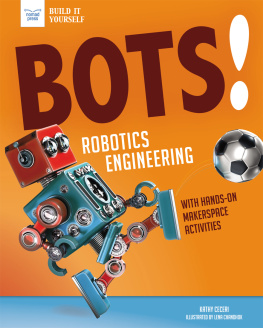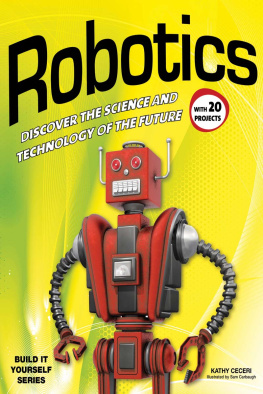Published in 2018 by The Rosen Publishing Group, Inc. 29 East 21st Street, New York, NY 10010
Copyright 2018 by The Rosen Publishing Group, Inc.
First Edition
All rights reserved. No part of this book may be reproduced in any form without permission in writing from the publisher, except by a reviewer.
Library of Congress Cataloging-in-Publication Data
Names: Baum, Margaux, author. | Chaffee, Joel, author.
Title: Engineering and building robots for competitions / Margaux Baum and Joel Chaffee.
Description: New York : Rosen Publishing, 2018. | Series: Hands-on robotics | Includes bibliographical references and index. | Audience: Grades 5-8. Identifiers: LCCN 2017026402| ISBN 9781499438871 (library bound) | ISBN 9781499438840 (pbk.) | ISBN 9781499438857 (6 pack)
Subjects: LCSH: Mobile robotsCompetitionsJuvenile literature. |
RobotsDesign and constructionJuvenile literature.
Classification: LCC TJ211.415 .B38 2018 | DDC 629.8/92dc23 LC record available at https://lccn.loc.gov/2017026402
Manufactured in the United States of America
R obotics competitions have become more popular than ever before, both within the United States and internationally. Once a pursuit for fringe hobbyists, robotics clubs and leagues now exist all over and are sanctioned and sponsored by schools at all levels (elementary, intermediate, and high school), colleges and universities, local organizations and trade groups, and technology organizations and associations, including many entities in the private sector. Besides being great fun, they also help incubate the next generation of roboticists, many of whom go on to higher education and employment in this expanding and important industry.
Such competitions are so widespread that young enthusiasts (and their clubs) have many to choose from. All competitions bring their inventors robotic creations head-to-head for challenges and contests. However, the rules, qualification criteria, focus, and many other parameters differ greatly among various competitions. Some are regional, others national or international in scope.
While technical know-how and skills in science, technology, engineering, and math (STEM) are obviously incredibly important pillars of a winning robot, a robotics competition also requires good teamwork, time management, and many other factors. Members of a technically superior team might not finish their project on time or be able to come together as a group to meet crucial milestones. Sometimes all it takes is one good idea and the ability to follow through on it.
Team members who band together for competitions have to be able to deal with stress and learn from mistakes, employing a trial-and-error approach, rather than being complete perfectionists. They must be flexible instead of rigid.

Robots fill the venue floor during the FIRST Robotics Competition held at Boston Universitys Agganis Arena in April 2011. The competition featured teams from in and around Boston and greater New England.
Many of the elements that go into successful showings in robotics competitions need to be in place long before a team fields robots in the actual contests. These include making sure to set up a club or competition team in ways that maximize everyones skills. Someone might be the best at bringing in and spending money. Another member might be best at leading the team, while others are most proficient at designing and building the actual robots.
Of course, winning competitions is the ultimate goal, and it can definitely feel great to win. But participating in robotics competitions helps young people in many ways. Participants build their technical skills and learn how to work in teams and on deadlines. Competitors at all levels can network with local robotics professionals and even influential members of groundbreaking robotics companies at the higher levels. They can make contacts that will help them in their educations and careers, gain mentors, and make lifelong friends. All in all, engineering and building robots for competition is great for those who try their hardest and are eager to learn.

T here are many different kinds of robotics competitions out there. Many limit their contests to all-student teams, though some are less stringent. A great majority of competitions are geared toward a particular age group or level of schooling for example, only freshmen and sophomores in high school, or only college-level pupils. Others are only open to school-based teams in particular regions, or even skill-set levels. Before you or your club or team sets its sights on entering a particular contest, it is vital to research it and its sponsors thoroughly, so as not to waste your time or that of the sanctioning bodies or sponsors.

Some robotics clubs take root in technology or engineering classes that college students, high schoolers, and even younger students are enrolled in.
THE BASICS OF COMPETITION
The competition needs to be far enough in advance for proper preparation of the robot. Preparation might take a while and may go over deadline, a fact that all clubs must keep in mind. Think about how much time can realistically be allocated to the goal. When in doubt, be conservative about the estimate, and if it seems there will not be enough time to prepare, there probably wont be. Competition winners choose competitions that allow time for building and testing.

Indoor arenas and outdoor tracks are not the only competition venues. A member of the robotics club at Jesuit High School in Sacramento, California, resets equipment while testing an aquatic robot.
If one is in the competition to win it (and who isnt?), then it is a good idea to examine what the winnings are. Is there a prize, and what is it? Sometimes the prize is cash that winners may spend however they like. At other times the prize is something else, like a scholarship, a job, a piece of equipment, or money toward a future project. Sometimes it is a combination of the two; but it can also be simply prestige in the robot-building community, and there may be no actual material prize.
How much money can be spent on the project is very important and will determine how competitive the project can realistically be. One may be a serious enthusiast and willing to back knowledge and expertise with a reasonable sum of money from private or family sources, but for some types of competitions ones personal resources simply wont have a chance against those backed by a large institutional sponsor, such as a university.

